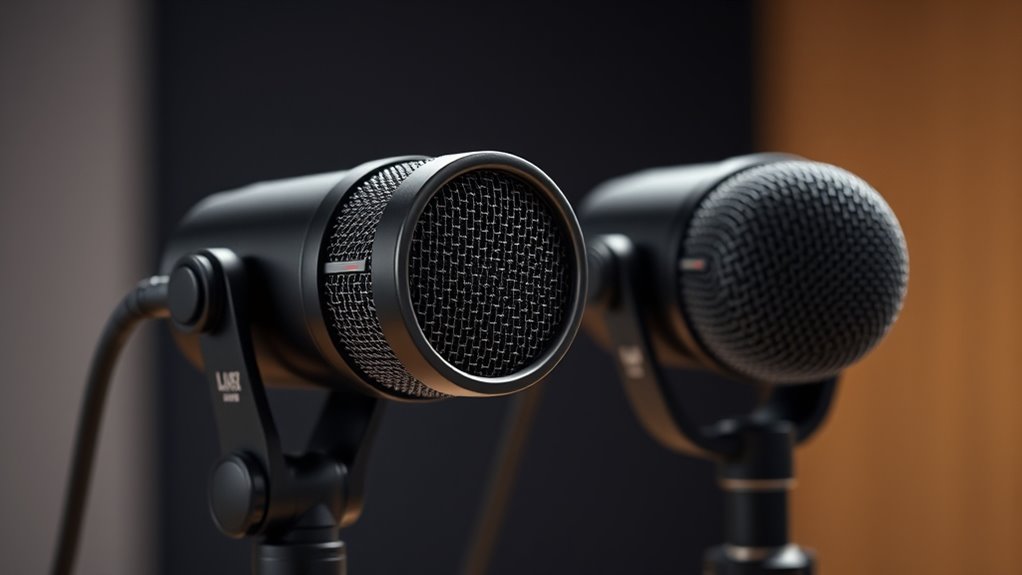Directional microphones are designed to focus on sounds from specific directions while reducing background noise. They use different polar patterns, like cardioid or supercardioid, to pick up mainly what’s in front of them and reject side or rear sounds. This makes them ideal for live performances, broadcasting, or recording in noisy environments. By understanding these patterns and techniques, you can improve your audio quality considerably—if you keep exploring, you’ll learn how to choose and use them effectively.
Key Takeaways
- Directional microphones focus on sound from specific directions, reducing ambient noise and improving clarity in recordings.
- Polar patterns like cardioid, supercardioid, and hypercardioid determine how a microphone picks up sound from different angles.
- Narrower polar patterns provide greater noise rejection, ideal for noisy environments or live performances.
- Techniques such as proximity effect and proper placement enhance the microphone’s focus on the desired sound source.
- Many microphones feature switchable polar patterns and advanced processing to optimize noise reduction in various recording settings.

Have you ever wondered how professionals capture clear sound in noisy environments? The secret often lies in the design of their microphones, specifically in the use of directional microphones with specialized polar patterns. These microphones are built to focus on sound coming from a particular direction while minimizing noise and unwanted sounds from other angles. This ability is vital in settings like live performances, broadcasting, or field recording, where background noise can easily drown out the main audio source. By understanding the concept of polar pattern, you can see how these microphones manage to isolate sound sources effectively. The polar pattern describes how a microphone picks up sound from different directions around its capsule. For example, some microphones have a cardioid pattern, which captures sound primarily from the front while rejecting sound from the sides and rear. This makes them ideal for capturing vocals or speech in noisy environments. Other patterns, like supercardioid or hypercardioid, offer even narrower pickup angles, providing greater noise reduction from the sides and rear, which is especially useful in crowded or unpredictable settings. When you choose a directional microphone, you’re essentially selecting a polar pattern that matches your need for noise reduction while maintaining clarity of the desired sound. Techniques such as proximity effect can also enhance this focus, where bringing the mic closer to the sound source boosts bass response and reduces background noise. This works hand-in-hand with the polar pattern to improve overall sound quality. Many professional microphones are designed with multiple polar patterns, giving you versatile options to adapt to different environments. Switching between patterns allows you to optimize noise reduction depending on the setting—whether you’re recording in a quiet studio or a bustling outdoor event. Additionally, some advanced microphones incorporate digital signal processing to further suppress background noise, complementing their physical polar pattern design. The goal is always to capture the cleanest, clearest sound possible, even amid chaos. Understanding how polar patterns influence noise reduction helps you make better choices when selecting a microphone, ensuring your audio is sharp and intelligible. Whether you’re recording a podcast, conducting an interview, or capturing live music, a directional microphone with an appropriate polar pattern can dramatically improve your results. It’s not just about picking the right microphone but understanding how its design influences the quality of your recordings. With the right combination of polar pattern and noise reduction techniques, you can focus on what matters most—your sound—without getting lost in the surrounding noise. This knowledge empowers you to set up your gear confidently, knowing you’re harnessing the full potential of directional microphones to deliver professional-quality audio every time.
Frequently Asked Questions
How Do Directional Microphones Differ From Omnidirectional Types?
You’ll notice that directional microphones differ from omnidirectional ones in their polar pattern, which focuses sound capture in specific directions. Directional mics pick up sounds primarily from one direction, reducing background noise, while omnidirectional mics capture sound equally from all around. This makes directional microphones ideal for isolating sound sources, whereas omnidirectional types are better for capturing ambient sound. Your choice depends on whether you need focused or full-range sound capture.
Can Directional Microphones Pick up Sound From All Directions?
No, directional microphones can’t pick up sound from all directions. Their polar pattern focuses on capturing sound primarily from one direction, reducing noise from other angles. You will notice that they excel at isolating sounds directly in front of them, like speech or specific sources. They minimize sound pickup from the sides and rear, making them ideal for situations where you want clarity and focus, but not for capturing sound from all directions simultaneously.
What Are the Best Uses for Shotgun Microphones?
You should use shotgun microphones for capturing focused audio in filmmaking, broadcast, or outdoor interviews. Their highly directional pickup pattern helps isolate your subject from background noise, making audio filtering easier. Guarantee your equipment compatibility by choosing a model with the right connectors and power options. Shotgun mics excel when you need clear, targeted sound, especially in noisy environments, providing professional results with minimal post-production editing.
How Does the Polar Pattern Affect Microphone Performance?
Did you know that polar pattern variations can dramatically influence a microphone’s ability to reject interference? Your choice of pattern affects how well it captures sound from certain directions while ignoring others. For instance, cardioid patterns excel at interference rejection from the sides, making them ideal for live recordings. Understanding how polar patterns impact performance helps you select the right microphone to reduce background noise and focus on your desired sound source.
Are There Any Disadvantages to Using Directional Microphones?
Yes, there are disadvantages to using directional microphones. They can pick up background noise if you’re not perfectly aimed, which may affect sound quality. Additionally, these microphones often come with higher equipment costs, making them less budget-friendly. You might also find that their narrow pickup pattern requires careful positioning, and they can be more fragile or sensitive to handling noise, so they demand more attention during use.
Conclusion
Now that you understand how directional microphones work, you’ll appreciate their power in capturing clear sound while minimizing background noise. Did you know that in noisy environments, these microphones can reduce unwanted sounds by up to 20 decibels? That’s like cutting out almost 90% of background noise! With this technology, you can focus on what matters most, whether it’s recording a concert or having a clear phone call. Embrace the precision and clarity directional microphones offer today.











